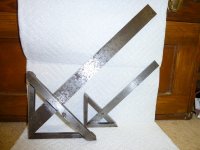Not enough wine Rivett! Your memory is correct.
To be specific, Joseph Rogers Brown took Lucian Sharpe as his partner in 1853.
In 1866 they teamed with Samuel Darling of Bangor Maine to to form Darling Brown & Sharpe as the name for their precision small tool line - not machinery.
In 1868 the J R Brown & Sharpe machinery line was reorganized to Brown & Sharpe Mfg. Co.
In 1892, Samuel Darling's widow was bought out, his name dropped and Brown & Sharpe Mfg. Co was the only name used throughout the entire line.
This thread gives me the opportunity to hear from those on this forum about the following:
What was JR's first logo?
I believe it is Rivett who has a vernier caliper in bronze marked "
JOS R BROWN" followed by what is likely "
MAKER".
I have about a dozen items marked "
J. R. Brown & Sharpe" that are 1850 to 1853 or a little later.
I have one tool (somewhere???) marked "
Joseph R. Brown & Sharpe".
And I have one tool (a center drill gage) marked "
Joseph R. Brown & Sharpe Makers".
I'm guessing:
1. "
JOS R BROWN" is the first logo,
2. "
Joseph R. Brown & Sharpe Makers " is the second,
3. "
Joseph R. Brown & Sharpe " is the third followed by
4. "
J. R. Brown & Sharpe", then
5. "
Darling Brown & Sharpe",
6. "
Brown & Sharpe Mfg. Co." and so on.
Anyone have a study? Anyone have other logos? How about a different time line?
And here is a little more to pique discussion. Before JR went on his own when his father left the family business in 1841, there first was the "David Brown" logo of his father (Clocks) prior to 1833 and then "D. Brown & Son" in 1833.
In 1850 J. R. invented his famous linear dividing engine and started his new machinist (wasn't it called "mechanics" tools then?) company we've been discussing above.
In 1851 he created the vernier caliper mentioned earlier.
It is written that Lucien Sharpe was Brown's apprentice for 5 years, so it must be that Sharpe stared with Brown in 1848 presumably under the name D. Brown & Son.
Please correct and add information!!









